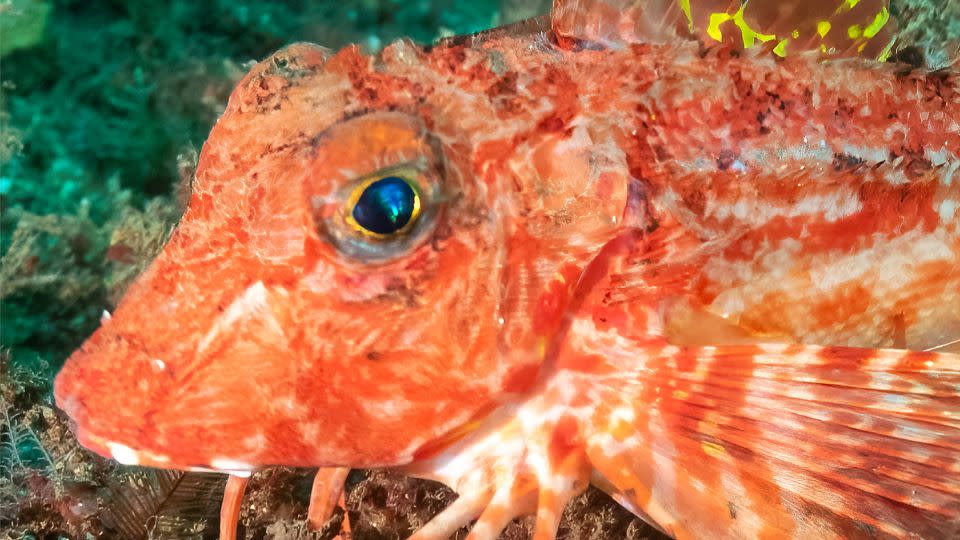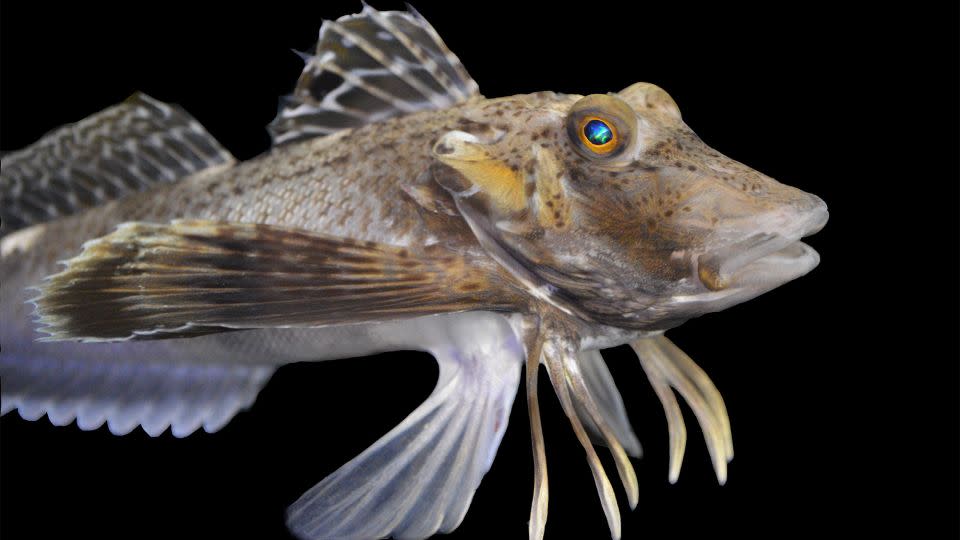Sign up for CNN’s Wonder Theory science newsletter. Explore the universe with news on fascinating discoveries, scientific advancements and more.
Some types of sea robins, a peculiar bottom-dwelling ocean fish, use taste bud-covered legs to sense and dig up prey along the seafloor, according to new research.
Sea robins are so adept at rooting out prey as they walk along the ocean floor on their six leglike appendages that other fish follow them around in the hope of snagging some freshly uncovered prey themselves, said the authors of two new studies published Thursday in the journal Current Biology.
David Kingsley, coauthor of both studies, first came across the fish in the summer of 2016 after giving a seminar at the Marine Biological Laboratory in Woods Hole, Massachusetts. Kingsley is the Rudy J. and Daphne Donohue Munzer Professor in the department of developmental biology at Stanford University’s School of Medicine.
Before leaving to catch a flight, Kingsley stopped at a small public aquarium, where he spied sea robins and their delicate fins, which resemble the feathery wings of a bird, as well as leglike appendages.
“The sea robins on display completely spun my head around because they had the body of a fish, the wings of a bird, and multiple legs like a crab,” Kingsley said in an email.
“I’d never seen a fish that looked like it was made of body parts from many different types of animals.”
Kingsley and his colleagues decided to study sea robins in a lab setting, uncovering a wealth of surprises, including the differences between sea robin species and the genetics responsible for their unusual traits, such as leglike fins that have evolved so that they largely function as sensory organs.
The findings of the study team’s new research show how evolution leads to complex adaptations in specific environments, such as the ability of sea robins to be able to “taste” prey using their quickly scurrying and highly sensitive appendages.


A highly unusual animal
The distinctive extremities of the sea robins are actually extensions of their pectoral fins, said study coauthor Amy Herbert, a postdoctoral scholar in Kingsley’s lab at Stanford.
“We settled on the term ‘legs’ because of the striking walking function of these appendages,” Herbert said in an email. “However, they do not have the same structure as human ‘legs’ nor are they in the same position.”
Other fish species have modifications to their pectoral or pelvic fins that allow them to walk or perch, but sea robins can move their legs individually, which makes them more adept at walking and digging, Herbert said.
“Sea robins are an example of a species with a very unusual, very novel trait,” lead study author Corey Allard said in a statement. “We wanted to use them as a model to ask, ‘How do you make a new organ?’” Allard is a postdoctoral fellow in the department of molecular and cellular biology at Harvard University, where he works in the lab of study coauthor Nick Bellono, a Harvard professor.
The researchers brought some sea robins back to Bellono’s lab for study and to see whether they could uncover buried prey. The team observed the fish alternating between short bouts of swimming and walking. They were also seen scratching at the sandy surface covering the bottoms of the tanks without any visual cues to let them know where prey might be buried.
“To our surprise, they were very, very good at it and could even uncover ground up and filtered mussel extract, and single amino acids,” Bellono said.
To continue their research, the study authors had more sea robins shipped to the lab — only to discover that they represented an entirely different species with varying traits.


Genetically distinct walking fish
The two sample groups of sea robins looked the same, but the newly delivered fish didn’t dig or find buried prey.
“This time, the new sea robins didn’t find anything, despite readily eating prey on the surface,” Bellono said by email. “We thought we were maybe doing something wrong, but it turned out that we accidentally got a different species.”
The mix-up enabled some serendipitous discoveries for the researchers. The highly sensitive fish they initially studied belonged to the species known as the northern sea robin, or Prionotus carolinus. And the fish that lacked sensory capabilities and used their legs mainly for walking were striped sea robins, or Prionotus evolans.
The digging sea robins had shovel-shaped legs that were covered in protrusions called papillae, which are similar to the taste buds on our tongues. Meanwhile, the non-digging sea robins had rod-shaped legs without any papillae.
As the scientists studied the fish on a genetic level and compared how their legs have developed over time, they realized that species that dig are only found in a few locations, such as the sandy shallow waters of New England and the upper eastern Atlantic seaboard, which suggests the fish only recently evolved this trait.
“We think that the digging and non-digging species are separated by around 10 (million) to 20 million years, which means that papillae would have had to emerge sometime after that,” Allard said.
While all the sea robin species have leglike appendages, only some have the macroscopic sensory organs that allow them to taste the environment, Kingsley said.
The study authors’ research revealed that digging sea robins depend on a regulatory gene called tbx3a not only to develop their specialized fin adaptations but also to form the papillae that cause them to dig. Tbx3 also plays a role in limb development in humans, mice, chickens and other fish species, according to the study authors.
“This is a fish that grew legs using the same genes that contribute to the development of our limbs and then repurposed these legs to find prey using the same genes our tongues use to taste food — pretty wild,” Bellono said.
But why did only some of the sea robins develop this sensory ability? The researchers have a couple of hypotheses.


“One is that using the legs to uncover buried prey” allows them a new way to seek out food than they could before, Herbert said. “Another is that walking rather than swimming in some environments may be more energy efficient for sea robins.”
Sea robins stand out among other walking fishes because their pectoral fins, also called walking fin rays, are highly jointed and their skeletal and muscular anatomy showcase unique modifications that enable sea robins to walk, said Jason Ramsay, assistant professor in the department of biology at Rhode Island College. But the fish also have adaptations in their nervous system that are related to their legs, suggesting their sensory function, Ramsay said. He was not involved in the new studies.


“A commonly asked question is, did these walking rays evolve due to selective (adaptation) pressures that support a walking function, sensory function, or some combination of both,” Ramsay said by email. “These new studies provide more evidence suggesting it was most-likely the latter-most scenario.”
Allard is starting his own lab at Harvard, while Herbert is beginning a lab at the University of Chicago. Both researchers said they are keen to uncover the exact mechanisms behind the evolution of the sea robins’ sensory appendages.
For more CNN news and newsletters create an account at CNN.com
